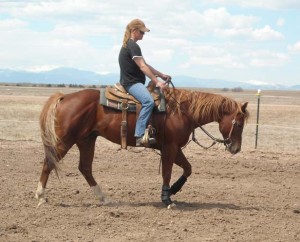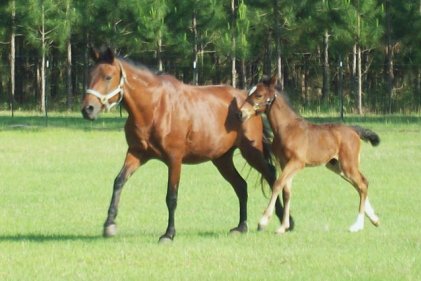 This is the fourth and final post in a series on how to train a horse. Every horse is different and might require a different method or more work in one area than another, so consider this just an overview. This advice is not meant to be a beginner’s only resource—I always suggest that a person find a mentor in the horse training business, and watch from a safe distance before they ever try starting a colt themselves.
This is the fourth and final post in a series on how to train a horse. Every horse is different and might require a different method or more work in one area than another, so consider this just an overview. This advice is not meant to be a beginner’s only resource—I always suggest that a person find a mentor in the horse training business, and watch from a safe distance before they ever try starting a colt themselves.
The previous posts covered saddling, bitting, and ground driving a horse in preparation for riding, and this post will explain how to go about getting on a horse’s back for the first time. The previous groundwork exercises will give your horse a good understanding of how he should behave under saddle, and the ground driving will establish a habit of giving to rein pressure and being controlled by the rider. So all that’s left is to climb on the horse, but there are still a few precautions to take and things to work through to make sure the horse is ready to accept a person in the saddle.
Just like every trainer can have their own method, so every colt can require a different way of going about something. I grew up around Quarter Horses that we had hand-raised, and they were very accepting and gentle. They really didn’t need a lot of gentling before they were ready to ride, but I have worked with a few horses that just didn’t want to be touched at all, and that kind of horse is going to take a lot more work before you can ride it. So you be the judge and determine if your horse is ready. You can never spend too much time petting, talking, rubbing, and leaning on a horse while it is in an environment it is comfortable with. A good time to work on gentling is while a horse eats his hay, because while he is partly focused on eating and will naturally want to stay near its feed, you can pet him and touch him all over and he will learn that being around a person is a good thing.
I like to ride in a round pen when I’m training horses, as it gives the horse a place to move but limits him enough that he won’t go getting into trouble or run away with you. The round pen is probably the safest place to get on a horse. If you don’t have access to a round pen, choose a small enclosure where the fencing is good. If you’re short for the height of your horse, you might want to use a mounting block, hay bale, or overturned bucket to step up on. You want to be able to reach over the saddle and touch the horse on the other side, pat the saddle all over, and lean over it without actually getting on. If the horse is uncomfortable with any of this, then repeat the action gently and persistently until it doesn’t bother him anymore.
I will usually step up in the stirrup and lean over the saddle, petting the horse on the other side and then stepping back down. If the horse tries to move during this, that’s fine, just try to pull the inside rein and turn him in a circle until he stops again. Repeat the stepping up, petting all over as far as you can reach, then stepping down again. Get the colt used to you being beside and above him. If he accepts all of this without getting too worried, then you can go ahead and swing your leg over and sit up in the saddle. If he attempts to walk forward, do not discourage him, simply keep your inside rein (the rein that will pull him towards the inside of the circle when you’re in a round pen, or the one you would choose to pull him in an arc if you aren’t in a round pen) shorter and ready to pull if he starts going to fast or spooks.
For the first ride, your main goal is to keep the colt calm, and have forward movement. You do not want the colt to “freeze up” when you get on, so if he tries to walk, let him. Some horses will stand stock still and get more nervous the longer they stand, and they begin to think they cannot move with a rider, and the unfamiliar weight begins to scare them until they blow up and buck sky high. So as soon as you get on, ask the colt to take a step forward and encourage him to turn by tightening the inside rein. Get him to walk a circle and then ask for a stop. Then ask him to move forward again. Use the same cues you used when you were ground driving, so it is all very familiar to him. If he doesn’t respond, you may need to lean forward a little in the saddle, or squeeze slightly with your legs. Any time the horse tries to go too fast, just use the inside rein to direct him in a smaller circle until he slows down. Don’t pull back on both reins unless the horse is bucking with you and you’re just trying to get his head up.
Your first ride doesn’t have to last too long or accomplish a lot of maneuvers. You basically want the horse to learn to carry your weight and move forward when you ask. You can do simple turns and change directions, and the colt should remember what he learned from ground driving, but again I wouldn’t ask a lot of a colt on the first ride. You don’t want to have any big fights with him, and you want the riding experience to be as pleasant as possible. Keeping things calm and easy will give a colt a good feeling about being ridden, and will help form a good foundation for all of your future rides.
These four blog posts on training a horse should give you a good start to riding your horse. Training a horse takes a lot of time and patience, and it never hurts to go back to the first lessons and repeat them. A horse can never have too much groundwork, and the more time you spend with the horse on learning these simple lessons, the better he will be. Keep your review lessons short and try to end them on a good note. For instance, you might start out by ground driving or lunging before each ride, but don’t work the horse for a long period of time on one task. When he is performing well, stop and do something different as a rest and reward from his work. This will help keep a colt in a good frame of mind for learning, and he won’t get bored with the same exercises over and over again.
With training horses, always remember that every horse is an individual and will have different strengths and weaknesses. If you can work on the things he has trouble with, and find a way to solve the problem that works for him, then you should consider yourself a good trainer. Every method isn’t for every horse, and you should learn to read a horse and adapt to fit his needs. Practice will make perfect, but it often takes a few tough rides at the beginning where you might feel that you’re not getting the idea across, but if you stick with it and find a way through it, both you and your horse will benefit from it.
Good luck!

